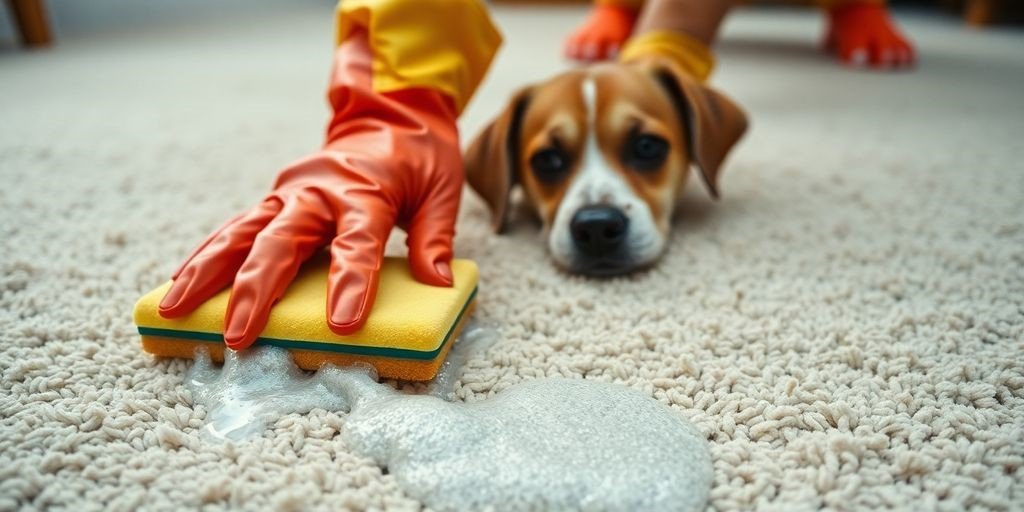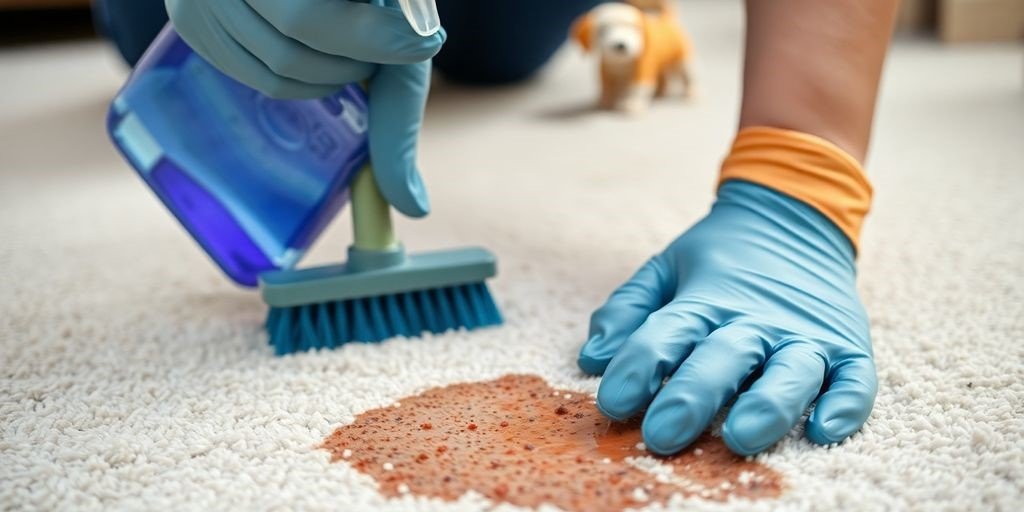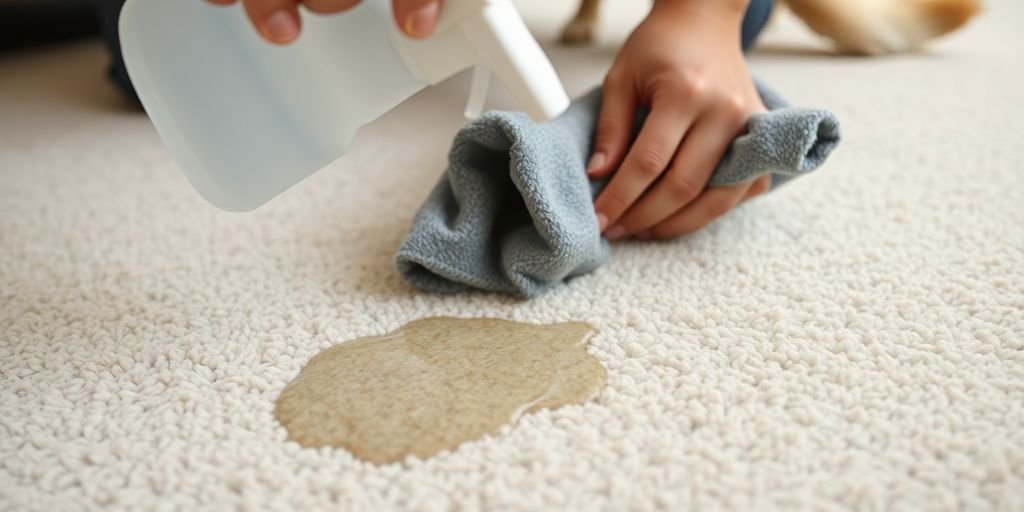Dealing with pet urine odor can be a real headache, especially if you’re in Denver and trying to keep your home fresh. That strong, lingering smell seems to stick around no matter what you do. But don’t worry, you can totally get rid of it.
This guide will walk you through some simple steps and methods for Pet Urine Odor Removal Denver, so your place can smell clean again.
Key Takeaways
- Act fast: The sooner you clean up pet urine, the better your chances of getting rid of the smell completely.
- Soak it up: Use paper towels or old cloths to blot up as much of the pee as you can before trying any cleaners.
- DIY options work: Things like vinegar, baking soda, and hydrogen peroxide can be really effective for cleaning up pet messes.
- Different surfaces need different care: What works on carpet might not be best for hardwood, so adjust your cleaning method.
- Prevention is key: Once you’ve cleaned up, think about ways to stop future accidents, like consistent training or vet visits.
Understanding Pet Urine and Odor
Why Pet Urine Odor Lingers
Okay, so you’ve got a whiff of that unmistakable pet urine smell. It’s not just unpleasant; it’s persistent. Why is that? Well, pet urine isn’t just water and waste.
It’s a complex cocktail of things like urea, uric acid, hormones, electrolytes, and bacteria. The uric acid is the real culprit here, as it crystallizes and clings to surfaces, making it incredibly difficult to remove with regular cleaning products.
Think of it like this:
- Regular cleaners might mask the smell temporarily.
- They don’t break down the uric acid crystals.
- The odor resurfaces as the crystals react to humidity.
So, what’s the solution? You need something that specifically targets and breaks down those uric acid crystals. That’s where enzymatic cleaners come in, but we’ll get to that later.
Accidents on the carpet can leave strong odors that linger and make your home uncomfortable. A1 Red Carpet offers expert pet urine odor removal services designed to target deep-set smells and stains. We use safe and effective cleaning methods to remove unpleasant odors at the source, not just mask them. Our team ensures your carpets smell fresh and look clean again. Whether it’s one spot or multiple areas, we’re ready to help.
Immediate Cleanup: The First Step

Time is of the essence when dealing with pet urine. The longer it sits, the harder it is to remove the odor. I remember one time my dog, Max, had an accident on the rug while I was out. By the time I got home, it was a disaster. The smell had really set in, and it took forever to get rid of it. So, trust me, act fast!
Tools and Materials for Quick Action
Having the right supplies on hand makes a huge difference. Here’s what I recommend keeping in your pet stain cleanup kit:
- Absorbent towels or paper towels: For soaking up as much urine as possible. Seriously, blot, don’t rub!
- Baking soda: This stuff is amazing for absorbing odors. I always have a box on hand.
- White vinegar: A natural cleaner and deodorizer. It’s my go-to for so many messes.
- Spray bottle: For applying cleaning solutions.
- Enzymatic cleaner: These are specially designed to break down the enzymes in pet urine.
Immediate action is key. The faster you address the accident, the less likely the odor will linger. Plus, it prevents the stain from setting in, which can be a real pain to remove later.
Here’s a quick guide on what to do immediately after you discover a fresh pet urine stain:
- Blot up as much urine as possible with absorbent towels. Apply pressure to soak it up.
- Cover the area with a thick layer of baking soda. Let it sit for at least 30 minutes, or even better, overnight. This will help absorb the remaining moisture and odor.
- Vacuum up the baking soda.
- Follow up with an enzymatic cleaner for a deeper clean. These cleaners contain enzymes that break down the uric acid crystals in pet urine, which are responsible for the lingering odor. Make sure to follow the product instructions carefully.
I’ve found that this process works best if you repeat it a couple of times, especially for older stains. Don’t get discouraged if the odor doesn’t disappear immediately. Persistence is key!
Effective DIY Pet Urine Odor Removal Methods

Enzymatic Cleaners: How They Work
Enzymatic cleaners are a game-changer when it comes to battling pet urine odors. They contain enzymes that break down the uric acid crystals found in pet urine, which are the primary source of that lingering smell. Unlike regular cleaners that simply mask the odor, enzymatic cleaners eliminate it at its source.
You can find these cleaners at most pet stores or online. When using an enzyme cleaner for pet urine odors, it’s important to follow the instructions carefully. Typically, you’ll need to saturate the affected area and allow the cleaner to sit for a specified amount of time so the enzymes can do their work.
Baking Soda and Vinegar Solutions
Baking soda and vinegar are two common household items that can be surprisingly effective in neutralizing pet urine odors. Here’s how you can use them:
- First, blot up as much of the fresh urine as possible with paper towels or a clean cloth.
- Next, generously sprinkle baking soda over the affected area. Baking soda is great at absorbing odors.
- Then, mix equal parts white vinegar and water in a spray bottle and lightly spray the baking soda-covered area. Don’t saturate it; just dampen it enough to activate the baking soda.
- Let the mixture sit for several hours, or even overnight, until it’s completely dry. The baking soda will form a crust as it dries.
- Finally, vacuum up the dried baking soda. The odor should be significantly reduced, if not completely gone.
This method works well because vinegar is acidic and helps to neutralize the alkaline salts that form in dried urine. The baking soda then absorbs the remaining odor and moisture. For stubborn odors, you may need to repeat the process a few times. If you are looking for the best way to remove pet urine smell, this is a great starting point before calling in professional pet stain removal Denver.
Tackling Odor on Different Surfaces
Carpet and Rugs
Carpets and rugs are notorious for trapping pet urine, making odor removal a challenge. The key is to act fast and saturate the affected area with an appropriate cleaner.
Here’s a step-by-step approach:
- Blot up as much fresh urine as possible with paper towels or a clean cloth. Apply pressure to absorb the liquid.
- Saturate the area with an enzymatic cleaner. These cleaners contain enzymes that break down the uric acid crystals responsible for the lingering odor. Follow the product’s instructions carefully.
- Let the cleaner sit for the recommended time (usually several hours or overnight). This allows the enzymes to fully penetrate and break down the urine.
- Blot up the remaining cleaner with clean towels. Avoid scrubbing, which can damage the carpet fibers.
- Allow the area to air dry completely. You can use a fan to speed up the process.
Hardwood Floors and Tile
You’d think hard floors wouldn’t absorb odors, and in some cases, that’s true. If you have linoleum or well-sealed hardwood, liquid will just bead up on top of it, allowing you to wipe away accidents easily.
However, if you have old hardwood floors, the liquid and its smell can seep into the material and any cracks, making it truly hard to eliminate. Hardwood and tile require a different approach than carpets.
- Wipe up the urine immediately with paper towels or a cloth. The faster you act, the less likely it is to soak into the floor.
- Clean the area with a solution of equal parts white vinegar and water. Vinegar is a natural deodorizer and can help neutralize the urine odor.
- For stubborn odors on hardwood, try applying a paste of baking soda and water. Let it sit for several hours, then wipe it away with a damp cloth.
- If the odor persists, consider using hydrogen peroxide. Dampen a paper towel with 3 percent hydrogen peroxide and lay it over the trouble spot for a few hours. Be careful, as hydrogen peroxide can discolor some finishes.
Upholstery and Fabrics
Upholstery and fabrics can be tricky to clean because they often can’t be easily washed. The key is to spot-treat the affected area and avoid soaking the fabric.
Here’s how to tackle urine odors on upholstery and fabrics:
- Blot up as much urine as possible with paper towels or a clean cloth. Press firmly to absorb the liquid.
- Test any cleaning solution on an inconspicuous area of the fabric first to ensure it doesn’t cause discoloration.
- Apply an enzymatic cleaner specifically designed for upholstery and fabrics. Follow the product’s instructions carefully.
- Let the cleaner sit for the recommended time, then blot it up with a clean cloth.
- Allow the area to air dry completely. You can use a fan to speed up the process.
If the odor persists, consider using a fabric refresher spray or having the upholstery professionally cleaned. You can also try a chlorine dioxide car odor eliminator for enclosed spaces like cars or small rooms with fabric upholstery.
At A1 Red Carpet, we specialize in pet urine odor removal services that go deep beneath the surface to eliminate smells at the source. Our advanced cleaning methods break down odor-causing bacteria, restoring freshness to your carpets and peace to your home. Whether it’s one spot or ongoing issues, we’ve got you covered.
Call us now for reliable cleaning services.
Frequently Asked Questions
Why does pet urine smell so strong?
Pet urine smells bad because of the chemicals in it, like ammonia. When urine dries, these chemicals break down and release a stronger, more unpleasant odor.
How quickly should I clean up pet accidents?
It’s best to clean up pet urine as soon as you find it. The longer it sits, the more it soaks into surfaces, making the smell harder to remove and possibly causing stains.
What are enzymatic cleaners and how do they work?
Enzymatic cleaners are special cleaners that have tiny helpers (enzymes) that break down the stuff in pet urine that causes the bad smell. They don’t just cover up the smell; they get rid of it.
Can I use common household products to clean pet urine?
For a simple homemade cleaner, you can mix white vinegar with water (half and half). For tougher smells, sprinkle baking soda on the wet spot, let it sit, then vacuum it up. You can also spray a mix of hydrogen peroxide and water on the spot after the vinegar solution.
What’s the best way to remove urine smell from different surfaces?
To get rid of the smell from carpets, first blot up as much pee as you can. Then, use an enzymatic cleaner or a mix of vinegar and water. For hard floors, wipe up the pee, then clean with a mild soap or a hydrogen peroxide solution. Always test cleaners in a hidden spot first.
How can I stop my pet from having accidents indoors?
To stop future accidents, make sure your pet has easy access to their potty spot (like a clean litter box or outside). You can also use pet pads, keep up with potty training, and talk to your vet if accidents keep happening, as it might be a health issue.

